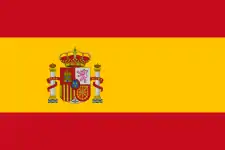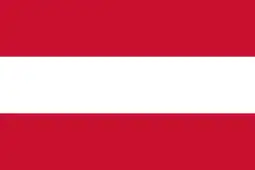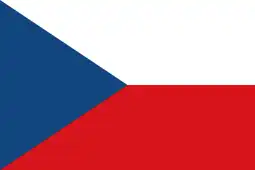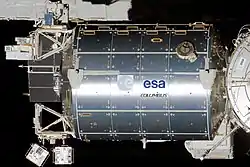.jpg.webp) | |
| Year selected | 2022 |
|---|---|
| Number selected | 5 Career, 12 Reserve/Project |
The 2022 European Space Agency Astronaut Group is the latest class of the European Astronaut Corps. The selection recruited five "career" astronauts as well as 12 "reserve/project" astronauts (including one "astronaut with a physical disability").[1] They are the fourth European Space Agency (ESA) astronaut class to be recruited.[2]
The group joined the continuing corps of ESA astronauts, those selected in 2009, to perform both long and short-duration spaceflight missions aboard the International Space Station, and as part of the Artemis program.[3][4]
Group members
Along with the five selected "career astronauts", the campaign recruited a "reserve" pool of astronauts who "...will not be permanent ESA staff, but could have the opportunity to be selected for specific projects, as project astronauts."[2] The campaign also recruited a person with a physical disability through the "parastronaut feasibility project".[5][6][4] The announcement of the selected candidates took place in Paris on November 23 2022 at the Grand Palais Éphémère, at the conclusion of the ESA Ministerial Council meeting.[7]
- Career astronauts
.jpg.webp)
_(cropped).jpg.webp)
.jpg.webp)
.jpg.webp)
.jpg.webp)
- Project astronauts
_(cropped).jpg.webp)
_(cropped).jpg.webp)
_(cropped)_(cropped).jpg.webp)
Reserves
- Meganne Christian
 Materials scientist[17]
Materials scientist[17] - Anthea Comellini
 Aerospace engineer[18]
Aerospace engineer[18] - Sara García Alonso
 Biomedical scientist [19]
Biomedical scientist [19] - Andrea Patassa
 Test pilot[20]
Test pilot[20] - Carmen Possnig
 Medical doctor[21]
Medical doctor[21] - Arnaud Prost
 Flight test engineer[22]
Flight test engineer[22] - Amelie Schoenenwald
 Immunologist[23]
Immunologist[23] - Aleš Svoboda
 Fighter pilot[24]
Fighter pilot[24] - Nicola Winter
 Fighter pilot[25]
Fighter pilot[25]
Missions
2023
Basic training for some of the group began throughout 2023 at the European Astronaut Center (EAC) facilities in Cologne, with a duration of approximately a year. The five selected "career" astronauts began in April,[26] joined by three members of the reserve who had received "project" astronaut assignments: McFall and Wandt in June,[27][28] and Uznański in September.[29]
2024
After being initially announced as a reserve Marcus Wandt will be the first of the group to undertake a spaceflight, as a "mission specialist" aboard Axiom-3, no earlier than January 2024, to the International Space Station.[30] It will be "the first commercial mission for an ESA-sponsored astronaut"[31] with the Swedish National Space Agency responsible to "negotiate directly with Axiom for the flight" following ESA director general signing of "letter of intent" in April 2023 for such a mission.[32][33] His training was performed in reverse-order to the norm, with the mission-specific content first then followed by basic training at EAC second.[34] Wandt's mission name will be "Muninn" and will partially coincide with Danish ESA astronaut Andreas Mogensen's mission "Huginn".[35][36]
In August 2023 the Polish government signed an agreement with ESA and Axiom have a polish citizen aboard a future Axiom flight. Although the agreement did no specify who would fly or when that mission would take place,[37] the Polish minister for Economic Development and Technology stated the intent was "to submit the candidature" of Uznański for a flight in 2024.[38]
Recruitment
| ESA press conferences | |
|---|---|
The recruitment campaign was announced at press conferences in February 2021.[39] Applications for the roles of "astronaut" and "astronaut (with a physical disability)" in the ESA Directorate of Human and Robotic Exploration Programmes were accepted between 31 March and 18 June of that year[40][41] and over 22 thousand applications were received.[42] The original deadline of May 28 was extended by three weeks due to Lithuania joining ESA as an associate-member of ESA, and its citizens therefore becoming eligible to apply, only a week before the original deadline.[43]
Criteria
Recruits could be a citizen of any ESA member or associate-member state.[note 1] Women were particularly encouraged to apply — in order to address the gender gap among astronauts[44] — as under 16% of applicants in the previous recruitment campaign were women.[5][45]
The minimum formal criteria included: being a citizen of an ESA member (or associate member) state under the age of 50; being between 150 and 190 cm tall (with possible exception under the astronaut with a disability category); a "normal weight" BMI range; fluency in English and another language; a master's degree in the Natural Sciences, Medicine, Engineering, Mathematics/Computer Sciences (plus three years of professional experience), or accreditation as an experimental test pilot; a "hearing capacity of 25 dB or better per ear"; and a current class 2 pilot's medical certificate.[46][2] Upon selection, recruits would then receive training in "...the essentials of being an astronaut, survival skills and the Russian language, before moving on to robotics, navigation, maintenance and spacewalks", and then receiving mission-specific training.[47]
The types of disability considered for astronaut with a disability program were lower limb deficiency (e.g. due to amputation or congenital limb deficiency), leg length difference, or short stature.[48]
Applicants
Applications from 22,523 candidates were received. They came from all eligible nationalities (including Lithuania), as well as 257 for the astronaut with a disability program.[49] This represented a 2.8x increase in the number of applications received compared to the previous ESA astronaut selection process.[50] Almost five and a half thousand applicants (24%) were women – up from 1287 (15.3%) female applicants in the previous selection process.[50] Estonia had the highest proportion of female applicants (38.6%), while Switzerland had the lowest (17.8%).[49]
With over seven thousand applications the largest number of applicants were French citizens, almost twice as many as the next most common applicant citizenship, Germans. It was speculated that the popularity of the call for applicants among French citizens was due to Thomas Pesquet's "Alpha" mission to the ISS beginning while the application period was open.[51] More than a thousand applications were also received from British, Spanish, Italian and Belgian citizens, while less than 100 applications were received from Estonians, Latvians, Lithuanians, Luxembourgers, and Slovenians.[52] ESA stressed that the eventual selection is "irrespective" of national funding of the organisation.[53]
| Austria |
Belgium |
Czech Republic |
Denmark |
Estonia |
|---|---|---|---|---|
| 466 (24.9%) | 1007 (22.8%) | 204 (18.1%) | 145 (24.1%) | 57 (38.6%) |
| Finland |
France |
Germany |
Greece |
Hungary |
| 308 (18.8%) | 7087 (23.2%) | 3695 (28%) | 281 (21.4%) | 149 (22.8%) |
| Ireland |
Italy |
Latvia |
Lithuania |
Luxembourg |
| 276 (28.3%) | 1845 (18.8%) | 83 (27.7%) | 80 (23.8%) | 64 (18.8%) |
| The Netherlands |
Norway |
Poland |
Portugal |
Romania |
| 982 (30.1%) | 391 (17.9%) | 549 (23.3%) | 320 (19.1%) | 254 (21.7%) |
| Slovenia |
Spain |
Sweden |
Switzerland |
United Kingdom |
| 62 (21%) | 1341 (22.2%) | 281 (18.1%) | 668 (17.8%) | 2000 (28.5%) |
Selection process
The selection process itself proceeds over six stages:[55]
- Screening of applicants was undertaken "on the basis of documents submitted, the application form and the screening questionnaire." It was initially expected that approximately 1500 (7%) applicants would be accepted through to stage 2.[51] By the conclusion of the 1st stage in January 2022, 1361 astronaut candidates and 27 disabled candidates were invited to the 2nd stage – including at least one man and one woman from every eligible nationality.[49][56]
- Initial tests consisted of "cognitive, technical, motor coordination and personality tests" administered by the German Aerospace Center in Hamburg.
- Assessment centre evaluation involved "additional psychometric tests, individual and group exercises and practical tests" administered at the European Astronaut Centre in Cologne.
- Medical tests assessed "physical and psychological condition in view of long-duration astronaut missions"[57] administered in Cologne and the Toulouse Space Centre, France.
- Panel interview assesses "technical and behavioural competencies" including a background check.
- Final interview with the ESA Director General at the agency headquarters in Paris.
| Recruitment
round[55] |
Applicants
(of which disab.) |
Completed | %♀ | % of previous | Ref. |
|---|---|---|---|---|---|
| Screening | 22,780 (257) | June 2021 | 24% | – | [49] |
| Initial tests | 1,388 (27) | March 2022 | 39% | 5.9% | [49] |
| Assessment centre | ~400 | May | ~28.8% | [57] | |
| Medical tests | June | ~25% | [57] | ||
| Panel interview | |||||
| Final interview | October | 40%+ | [58] | ||
| Selected | 23 November 2022[7] | [1] | |||
| Career | 5 | 40% | |||
| Reserve/Project | 12 (1) | 50% | |||
See also
Notes
- ↑ At the time, ESA members nations were: Austria, Belgium, the Czech Republic, Denmark, Estonia, Finland, France, Germany, Greece, Hungary, Ireland, Italy, Luxembourg, the Netherlands, Norway, Poland, Portugal, Romania, Spain, Sweden, Switzerland, and the United Kingdom. Associate-members were Slovenia, Latvia, and Lithuania.[2] [43]
- ↑ While many applicants hold multiple citizenships, for statistical purposes ESA categorises them according to their self-declared first citizenship.
References
- 1 2 "ESA presents new generation of ESA astronauts". www.esa.int. Retrieved 2022-11-23.
- 1 2 3 4 "Astronaut selection 2021-22 FAQs". www.esa.int. Archived from the original on 2022-08-24. Retrieved 2021-02-16.
- ↑ "Hunt on to find British astronaut to go to the moon - here's what you need to qualify". Sky News. Archived from the original on 2021-06-17. Retrieved 2021-02-16.
- 1 2 "Europe launches recruitment drive for female and disabled astronauts". the Guardian. 2021-02-17. Archived from the original on 2022-07-28. Retrieved 2021-02-17.
- 1 2 "European Space Agency: Astronaut recruitment seeks disability applicants". BBC News. 2021-02-16. Archived from the original on 2022-05-07. Retrieved 2021-02-16.
- ↑ "European Space Agency in bid to recruit female and disabled astronauts". euronews. 2021-02-16. Archived from the original on 2021-10-26. Retrieved 2021-02-17.
- 1 2 "Media Invitation: Announcement of ESA Astronaut Class of 2022". www.esa.int. Retrieved 2022-11-08.
- ↑ helicopter test pilot"Sophie Adenot". www.esa.int. Retrieved 2022-11-23.
- ↑ "Pablo Álvarez Fernández". www.esa.int. Retrieved 2022-11-23.
- ↑ "Rosemary Coogan". www.esa.int. Retrieved 2022-11-23.
- ↑ "Raphaël Liégeois". www.esa.int. Retrieved 2022-11-23.
- ↑ "Marco Alain Sieber". www.esa.int. Retrieved 2022-11-23.
- ↑ "John McFall". European Space Agency. 2022-11-23.
- ↑ "Marcus Wandt". www.esa.int. Retrieved 2022-11-23.
- ↑ "Axiom Space Announces Astronauts for Third Mission to ISS". Axiom Space. 2023-09-12. Retrieved 2023-09-15.
- ↑ "Sławosz Uznański". www.esa.int. Retrieved 2022-11-23.
- ↑ "Meganne Christian". www.esa.int. Retrieved 2022-11-23.
- ↑ "Anthea Comellini". www.esa.int. Retrieved 2022-11-23.
- ↑ "Sara García Alonso". www.esa.int. Retrieved 2022-11-23.
- ↑ "Andrea Patassa". www.esa.int. Retrieved 2022-11-23.
- ↑ "Carmen Possnig". www.esa.int. Retrieved 2022-11-23.
- ↑ "Arnaud Prost". www.esa.int. Retrieved 2022-11-23.
- ↑ "Amelie Schoenenwald". www.esa.int. Retrieved 2022-11-23.
- ↑ "Aleš Svoboda". www.esa.int. Retrieved 2022-11-23.
- ↑ "Nicola Winter". www.esa.int. Retrieved 2022-11-23.
- ↑ "ESA's astronaut candidates start training". www.esa.int. Retrieved 2023-04-04.
- ↑ "John McFall: World's first disabled astronaut begins training". BBC Newsround. 2023-06-19. Retrieved 2023-09-15.
- ↑ "ESA proposes Marcus Wandt from Sweden to fly on a future Axiom space mission". www.esa.int. Retrieved 2023-09-15.
- ↑ "Sławosz Uznański from Poland to train as a project astronaut at the European Astronaut Centre". www.esa.int. Retrieved 2023-09-15.
- ↑ "Marcus Wandt will fly to International Space Station on third Axiom Space mission". www.esa.int. Retrieved 2023-10-01.
- ↑ "NASA, Partners Clear Axiom Space's Third Private Astronaut Crew – NASA". Retrieved 2023-10-01.
- ↑ "Sweden intends to send ESA astronaut to the International Space Station". www.esa.int. Retrieved 2023-10-01.
- ↑ "Axiom Space, ESA Sign Agreement with Swedish National Space Agency on Future Mission to ISS". Axiom Space. 2023-04-21. Retrieved 2023-10-01.
- ↑ Foust, Jeff (2023-10-18). "Axiom Space refines training for next private astronaut mission". SpaceNews. Retrieved 2023-10-19.
- ↑ Elizabeth Howell (2023-09-13). "Axiom Space names Ax-3 astronaut crew for SpaceX mission to ISS". Space.com. Retrieved 2023-09-15.
- ↑ Robert Lea (2023-06-20). "Swedish astronaut 'fast-tracked' to join crew of upcoming private Axiom Space mission". Space.com. Retrieved 2023-09-15.
- ↑ Foust, Jeff (2023-08-18). "Poland signs agreement to fly astronaut on Axiom Space ISS mission". SpaceNews. Retrieved 2023-10-01.
- ↑ "Polish astronaut to become second ever Pole to go into space". www.thefirstnews.com. Retrieved 2023-10-01.
- ↑ "Watch live: ESA outlines its search for astronauts". www.esa.int. Archived from the original on 2022-02-10. Retrieved 2021-02-16.
- ↑ "Astronaut Job Req ID: 12355". jobs.esa.int. 2021-03-31. Archived from the original on 2021-03-31. Retrieved 2021-04-01.
- ↑ "Astronaut (with a physical disability) Job Req ID: 12354". jobs.esa.int. 2021-03-31. Archived from the original on 2021-03-31. Retrieved 2021-04-01.
- ↑ "Final figures show astronaut applicants from all ESA Member States". www.esa.int. Archived from the original on 2022-07-12. Retrieved 2022-02-10.
- 1 2 "ESA extends deadline for astronaut applications as new Associate Member joins". www.esa.int. 2021-05-21. Archived from the original on 2022-04-04. Retrieved 2021-05-26.
- ↑ "Women and people with disabilities 'often better adapted to spaceflight than men'". www.abc.net.au. 2021-02-17. Archived from the original on 2021-04-28. Retrieved 2021-02-18.
- ↑ "Applicants from all ESA Member States to become European astronauts". www.esa.int. Archived from the original on 2021-12-29. Retrieved 2021-02-18.
- ↑ "Astronaut Application Handbook" (PDF). European Space Agency. 2021-03-31. p. 19. Archived (PDF) from the original on 2021-03-31. Retrieved 2021-03-31.
- ↑ O’Leary, Naomi. "European Space Agency launches search for new astronauts". The Irish Times. Archived from the original on 2021-02-17. Retrieved 2021-02-18.
- ↑ "Parastronaut feasibility project". www.esa.int. Archived from the original on 2021-02-16. Retrieved 2021-02-16.
- 1 2 3 4 5 6 "Final figures show astronaut applicants from all ESA Member States". www.esa.int. Archived from the original on 2022-07-12. Retrieved 2022-02-10.
- 1 2 "Wide range of applications for ESA's astronaut selection". www.esa.int. Archived from the original on 2021-12-30. Retrieved 2021-06-23.
- 1 2 "Big numbers apply to be European astronauts". BBC News. 2021-06-23. Archived from the original on 2022-08-15. Retrieved 2021-06-23.
- ↑ "ESA Astronaut Selection 2021: Preliminary Numbers" (PDF). European Space Agency. 2021-06-23. p. 3. Archived (PDF) from the original on 2021-06-23. Retrieved 2021-06-23.
- ↑ "European Space Agency: Astronaut recruitment drive for greater diversity". BBC News. 2021-02-16. Archived from the original on 2022-05-07. Retrieved 2021-06-23.
- ↑ "Announcement of ESA's new class of astronauts". Also broadcast live on YouTube. European Space Agency. 23 November 2022.
- 1 2 "Astronaut Application Handbook" (PDF). European Space Agency. 2021-03-31. p. 13. Archived (PDF) from the original on 2021-03-31. Retrieved 2021-03-31.
- ↑ "Astronaut selection: stage one complete". www.esa.int. Archived from the original on 2022-06-27. Retrieved 2022-01-18.
- 1 2 3 "ESA astronaut selection in the final stages". www.esa.int. Archived from the original on 2022-08-26. Retrieved 2022-07-07.
- ↑ Aschbacher, Josef (18 October 2022). "Samantha Cristoforetti's first news conference after returning to Earth". European Space Agency. min:42-46.
External links
- ESA recruitment website YourWayToSpace and astronaut application handbook


.jpg.webp)

.jpg.webp)